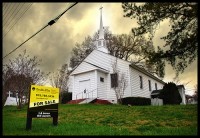 As we look at ways to help churches become more missional and organic, we have been discussing the problems of church buildings and the inherent restrictions they cause.
As we look at ways to help churches become more missional and organic, we have been discussing the problems of church buildings and the inherent restrictions they cause.
One solution is simply to sell your church building.
If your church has more than 20 people, you probably feel that selling your building is not an option. It may be fine for a church of a dozen people to meet in someone’s house, but that is unrealistic for a church of 50 or 100, let alone a church of 1000 or more.
But if a church really wants to escape the pitfalls of power and control that come with buildings, there are only two options: you must either sell the building or find another way to break free of the issues and pitfalls of owning a building.
In this post, we will look at how your church could still function if you decide to sell it. In a laster post, we will survey some suggestions for redeeming your building if you retain it.
If you are going to sell your building, but you still need a place to meet, there are only a few options. No, you will not have to meet in an old circus tent or under a tree somewhere, though if either of those fit your situation, they are not necessarily bad ideas. Remember, Saddleback Community Church started out by meeting in tents, and many African churches still meet under trees. But these options are not available or possible for most.
There are three realistic options for churches that sell their buildings but still need a place to meet: they either need to find a place that is free, find a place to rent, or break up into smaller units. Let us look at each.
1. Find a place that is free.
 There are many possibilities for free places to meet. Sometimes other churches might let you use their facilities for free, though often not at times you want. Another option might be to use a community center, but many of these also require rental fees. Some churches meet in local parks, on beaches, or in campgrounds. Recently, a coworker of mine told me that he was out hiking in the woods, and stumbled into a church service in the middle of the woods. That sounds a little cultish, but it could be fun.
There are many possibilities for free places to meet. Sometimes other churches might let you use their facilities for free, though often not at times you want. Another option might be to use a community center, but many of these also require rental fees. Some churches meet in local parks, on beaches, or in campgrounds. Recently, a coworker of mine told me that he was out hiking in the woods, and stumbled into a church service in the middle of the woods. That sounds a little cultish, but it could be fun.
Occasionally, local bars, restaurants, or coffee houses will allow churches to meet for free, as long as people buy food and beverages. This often works out well since many of these sites already have sound equipment set up. But again, bars are generally not large enough to accommodate too many people, and it is often difficult to do anything with children.
2. Find a place to rent.
All of the “free” options are generally also available to rent. In addition, churches might meet in school auditoriums, theaters, hotels, YMCAs, conference rooms, restaurants, and any other place that has an open room. One of the difficulties with these areas, as well as with the free areas, is setting up. If your church is over fifty, setting up chairs and a sound system every week can get tiresome.
However, it can be done. Rolling Hills Baptist Church in Fayetteville, GA decided that to have more money for outreach and service in the community, they should sell their building. The church has more than 100 people who attend, had owned the building for more than 20 years, and decided to rent another facility in town at about one-third the cost of owning. When interviewed, here is what the pastor said:
“The church has a new mission. Instead of investing in the property that consumed most of their budget, they will use the more than $1-million dollars from the sale to invest in people who have needs. “It’s just a way of looking at this property differently,” Pastor Mercer said. “We saw it as an asset we could liquidate and turn around and use that resource to meet the needs of people.”
3. Break up into smaller units.
 The third option is a combination of finding a place that’s free and finding a place to rent, and avoids most of the labor-intensive setup and takedown. This option is to become something like a network of cell groups. In this instance, the church decides that it does not have to meet as a large congregation every week, but only needs to meet every six weeks, or once a quarter.
The third option is a combination of finding a place that’s free and finding a place to rent, and avoids most of the labor-intensive setup and takedown. This option is to become something like a network of cell groups. In this instance, the church decides that it does not have to meet as a large congregation every week, but only needs to meet every six weeks, or once a quarter.
On these large gathering days, a place will be rented and set up to accommodate everyone. During the rest of the weeks, the church meets in smaller units of 5-15, meeting in free locations of their choice. Some might meet weekly at the beach. Others at Starbucks. Some in homes or parks.
This third option is probably the best, since it allows the church to spread out in the community for the greatest impact, is the least expensive, and provides a way for the greatest intimacy and fellowship among the members.
If you are still not ready to take this plunge there are ways to redeem your building, which we will look at tomorrow.




Great idea! I participated in a similar discussion a couple of years ago, but no one involved in the discussion had heard of any church that had actually done it. Do you have a link to more info. that tells us more about what is happening with the church in Georgia?
Our little group meets in cafes, in parks, in the street and occasionally in homes. This makes us very approachable as we mingle with the community. I definitely recommend it, especially for small groups. Larger groups can break up into small groups, perhaps once a month. One group could meet in cafe A, another in cafe B, one in the park, and the others could pick up trash in the neighborhood.
Even rented facilities usually tend to segregate us from the community. I love mingling with the people. We don’t need a sound system. Love goes a lot farther than noise, if you know what I mean.
Other than the link which I included in the post, I do not have more information on that church in Georgia. I heard of a church in Oregon that did something similar, but I scoured my files and the internet high and low and could not find the article which I had read a while back about it.
I think that more and more churches are moving toward this.
When I click on the link, I get the message “The page you are looking for cannot be found.”
Ok, it works now. Thanks for noticing this.
We’ve done similar things here for over 10 years now. Usually twice per week, we would gather in two different restaurants in a corner wing of their dining room. The management never had a problem with us being there. One in particular, who were ironically from the Middle East and had an Islamic background, often commented how much they enjoyed having us there. We purchased coffee and meals while there and did not take advantage of them. If we saw that the restaurant was getting busy and they needed the space, we would leave in order to free up some space for others. On top of this, we also meet regularly in homes and other coffee shops throughout the week. It’s an awesome way to get together as the church without all the overhead expenses of church property. Now, I simply cannot imagine going back into a structured institutional-type system.
Will,
That is so great! And it looks so much like Jesus. Out in the community, not huddled up in a building somewhere, safe and secure, but making absolutely no impact in the neighborhood, and not being a blessing to anybody.